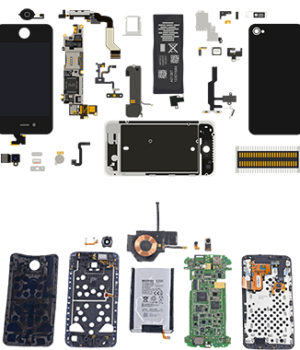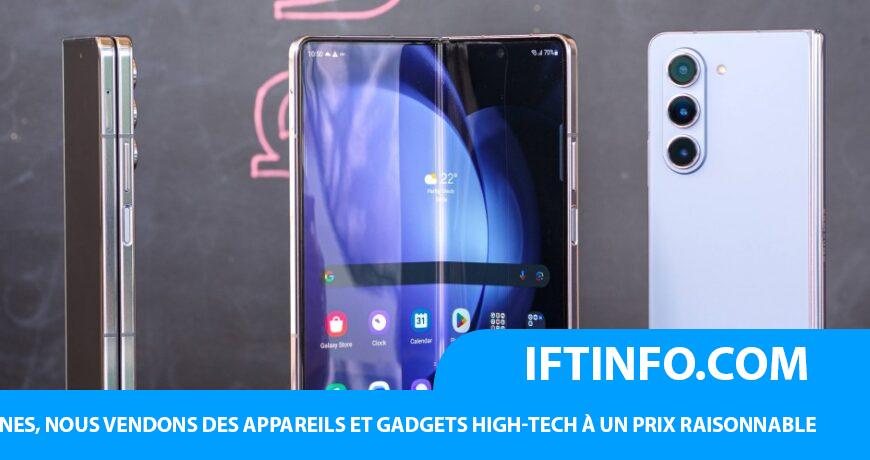IFTINFO – Samsung Galaxy Z Fold5 in for review laissez un commentaire
[ad_1]
You’d think that the bendy display is the hardest part about making a foldable phone, but OLED panels have been built on flexible plastic substrates for years now. The part that is actually hard is the hinge – Samsung took five generations to get it right.
The new Flex Hinge allows the Galaxy Z Fold5 to close flat – the gap between the two halves was among the things that caused the most complaints on previous Z generations. Aesthetically it looks better as it makes the phone symmetrical, but it has practical advantages too.
The gap added to the closed thickness, pushing the Z Fold4 up to 15.8mm. With no gap and thinner halves (6.1mm, down from 6.3mm), the Z Fold5 now closes to 13.4mm. Still thick, but getting closer to normal territory. The new model also shaved 10g off the weight, so the new Fold tips the scales at 253g. This isn’t readily apparent without a side-by-side comparison, but it’s something that you will appreciate with prolonged usage (for comparison, an S23 Ultra is 234g).
Removing the gap and slimming the halves made the Z Fold5 thinner
Samsung boosted the protection of the cover display and rear panel with Corning’s new Victus 2 (up from Victus+). There’s no dust resistance, though. TM Roh says that this is a hard problem to crack and the company is still working on it. Like before, the phone is rated IPX8 for submersion and the automated tests also cover IPX4 (spraying the phone with nozzles).
There’s no built-in silo for the S Pen, but Samsung introduced a new case design that is more compact than last year’s Standing Cover with Pen. The new S Pen is much slimmer, so it doesn’t add much bulk. It snaps into a raised slot and can be retrieved easily by pulling on the slider that pops it back out. Another improvement is that the new S Pen is available in some bright colors, adding back some fun that we’ve been missing since the Note9.
The cover and internal displays are the same as last year – 6.2” 23.1:9 and 7.6” 10.8:9 – except that Samsung managed to boost the peak brightness to 1,750 nits (up from 1,300 nits) and the high brightness mode now aims at 1,200 nits (up from 1,000 nits). This makes them easier to use on sunny days. Like before, the inner display can vary its refresh rate from 1Hz to 120Hz, the cover display is limited to the 48-120Hz range.
6.2” cover display and 7.6” internal display
As we have noted previously, the Galaxy Z Fold5 is more of an iterative upgrade over its predecessor. The hinge is a major improvement, but the 2022 Fold already had a capable cover display, so not much to improve on that front (unlike the Z Flip4, which was starting to feel behind the times).
The chipset is the only other major upgrade on the 2023 model with the Snapdragon 8 Gen 2 for Galaxy, the same chip that we saw on the Galaxy S23 series. The new chip marks a major improvement in single and multi-core performance compared to the Z Fold4 (which had the 8+ Gen 1), graphics are seeing a solid uptick in performance too. For more, you can check out the benchmarks of the Z Fold5.
The camera system is the same as last year – a 50MP main sensor (with 1.0µm pixels and an f/1.8 lens with OIS), 10MP telephoto cam (3x) and a 12MP ultra wide (123°). There is the 10MP selfie cam on the cover display and the 4MP under display cam on the inside. Of course, the extra processing power available with the new Snapdragon could produce better results, but that will have to wait for the full review. In case you missed them, here are some camera samples from the Z Fold5 camera from around Seoul.
Same 50+10+12MP rear camera • 4MP under display camera
The phone’s battery didn’t change either, it’s the same 4,400mAh power cell as last year. The 8 Gen 2 chip has been specifically optimized for the TSMC foundry and the newer cores are tweaked for power efficiency, so we might still see a higher endurance.
As you can probably tell, there are questions that can only be answered through the detailed tests we run for our reviews, so we’re off to do just that.
[ad_2]








